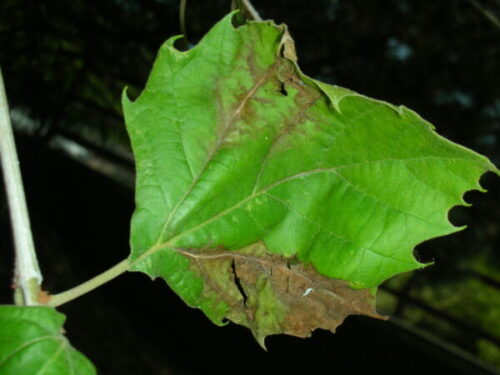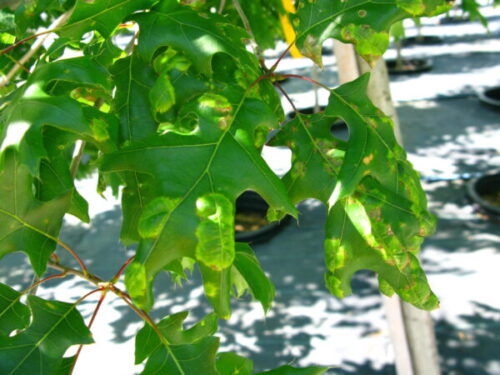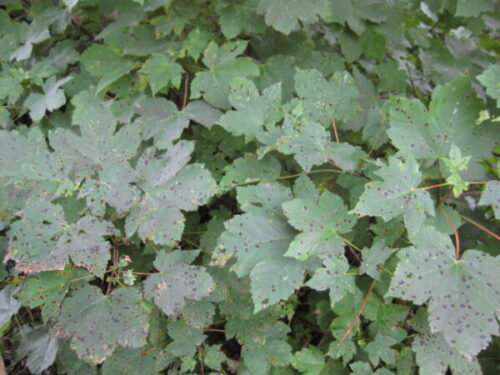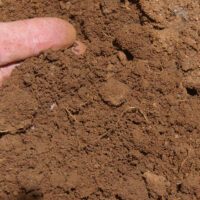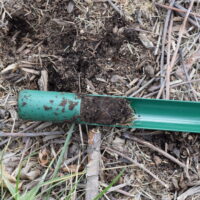 Purdue University - Extension - Forestry and Natural Resources
Purdue University - Extension - Forestry and Natural Resources
Got Nature? Blog
Purdue Landscape Report: Pruning is an important maintenance practice on trees that is discussed a great deal. An essential part of making the pruning cut properly is the ability to identify the parts of a branch. Identification of the branch bark ridge and branch collar are vital to severing the branch in a place that facilitates fast and effective wound closure, reducing decay in the location of the cut.
Branches on trees arise from lateral buds present in leaf axils. Initially, lateral shoots (branches) grow in length and diameter at approximately the same rate as the parent stem. As branches become shaded naturally by crown expansion, photosynthesis is reduced in that location and growth slows to a lesser rate than the parent or main stem. A swollen area or collar develops at the junction of branch and stem because of their differential growth rates and by the intermingling of vascular tissues from both the branch and the stem or trunk.
This swollen area is commonly referred to as a branch collar and often present in many branches on the underside of the branch. This specialized location on the branch is composed of trunk (parent stem) wood. The branch collar contains a protective chemical zone that inhibits the movement of decay organisms from dead or dying branches into healthy tissues of the parent stem. As branches begin to die from shading, pests or storm damage, for examples, they usually are walled off (compartmentalized) by tissues in the branch collar which prevents movement of decay organisms into the parent stem.
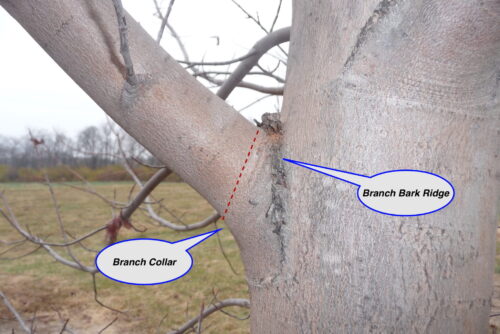
Identify the branch collar and branch bark ridge to perform a good cut, which is just outside the line.
Another important branch component to identify in tree branches is the branch bark ridge. This part of the attachment is composed of rough, usually darkened, raised bark formed at the union where the branch meets the parent stem. The ridge extends from the top of the branch down both sides of the branch union. Together with the branch collar, the portion of the ridge pushed up in the union provides our target for the pruning cut. The BBR is present on every branch union and is an important identifying feature for determining tool placement.
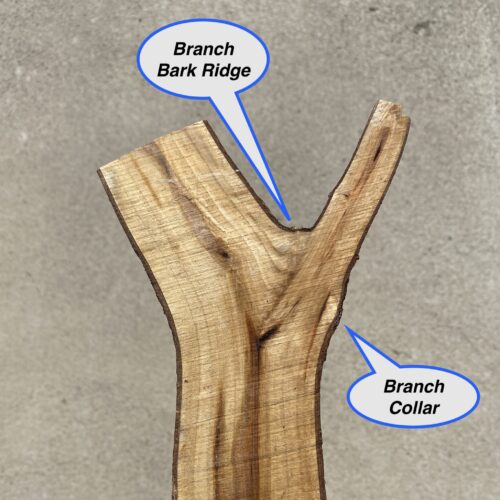
An internal view of the branch collar and branch bark ridge revealing the intermingled stem and branch wood fiber.
The combination of the branch collar, branch bark ridge, and the overlap between the branch and stem are the branch components that form what is called the branch protection zone. This zone contains specialized chemical compounds that help resist the spread of disease in the tree and facilitate wound-sealing. Always avoid damaging the area within the branch collar and branch bark ridge to help the tree recover from the pruning cut as quickly as possible.
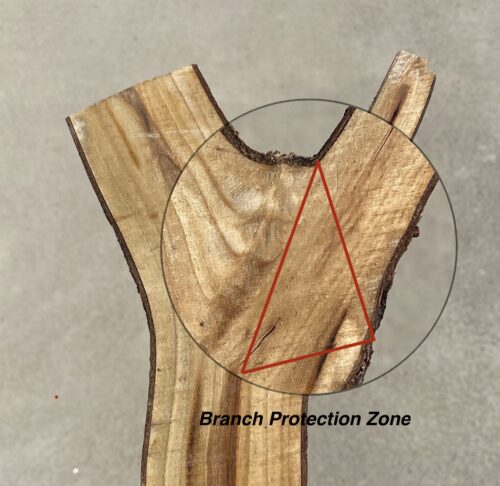
The Branch Protection Zone is an area that contains specialized chemicals to assist with the healing process after pruning.
For the best advice on tree maintenance and care, seek out a tree care professional with the experience and expertise to care for your trees. Search for a tree care provider in your area. Also, consider hiring an ISA Certified Arborist which can be found here.
Resources:
Planting Your Tree Part 1: Choosing Your Tree, Purdue Extension YouTube Channel
Tree Planting Part 2: Planting a Tree, Purdue Extension YouTube Channel
Tree Selection for the “Un-natural” Environment, The Education Store, Purdue Extension resource center
Tree Installation: Process and Practices, The Education Store
Tree Pruning Essentials, The Education Store
Tree Pruning Essentials Video, Purdue Extension YouTube Channel
Purdue Landscape Report
Lindsey Purcell, Urban Forestry Specialist
Purdue Department of Forestry and Natural Resources
Purdue Landscape Report: While fungi are responsible for many of our foliar disease problems, different fungal pathogens present as problems throughout the country, depending upon the host plant grown and the environmental conditions. This is a brief overview of several common types of fungal leaf diseases that occur in Indiana and throughout North America (and Europe). Recognizing the symptoms and signs is an important first step to diagnose a disease problem, followed by how to manage these diseases by combining cultural and chemical controls.
Common fungal leaf diseases of deciduous trees and shrubs
Anthracnose. Anthracnose diseases probably are the best-known foliar fungal diseases of deciduous trees. They affect many ornamental trees including major shade-tree genera such as sycamore (Platanus spp.), oak (Quercus spp.), maple (Acer spp.), elm (Ulmus spp.) and ash (Fraxinus spp.) (Fig. 1). Anthracnose actually is a general term describing symptoms such as dead irregular areas that form along and between the main vein of the leaf. The leaves may also become curled and distorted and twigs may die back. The fungus overwinters in infected twigs and the petioles of fallen leaves, and the spores disseminate in the spring by wind and splashing rain. The disease, while unsightly, rarely results in the tree’s death. Sycamores and other trees often withstand many years of partial defoliation. However, one anthracnose disease is more serious. Dogwood anthracnose (Discula destructiva) is a devastating problem on the Eastern seaboard, but has not been a significant issue here in Indiana.
Leaf blisters result in the blistering, curling and puckering of leaf tissue. Oak leaf blister (Taphrina caerulescens) is a common blister disease of oaks (Fig. 2)., particularly the red oak subgenus, which includes Northern red oak (Q. rubra) and pin oak (Q. palustris) among others. The symptoms begin as a slight yellowing of the infected leaf followed by round, raised blisters. These turn brown, and the infected leaves fall prematurely. This fungus overwinters as spores on the buds.
Leaf spot is a general symptom caused by a multitude of pathogens and infect all deciduous trees and shrubs, and include dead spots with a defined boundary between living and dead tissue. The dead tissue often separates from the surrounding living tissue creating a “shot-hole” appearance on the infected leaves. Common hosts include dogwood, maples, hydrangea, rose, holly, and Indian-hawthorn.
Tar spot (Rhytisma spp.) is a leaf disease with initial symptoms similar to leaf spot. The disease is most common on red (Acer rubrum) and silver maple (A. saccharinum) (Fig.3), but it can occur on a wide range of maple species from sugar (A. saccharum) and Norway (A. platanoides) to bigleaf maple (A. macrophyllum). The symptoms begin in the spring as small greenish-yellow spots on the upper leaf surface that, by mid-summer, progress to black tar-like spots about 0.5 inch in size. The disease is not fatal to the tree, but the appearance of the tar spots alarms some tree owners. A major outbreak in New York about 10 years ago left many maples completely defoliated by mid-August.
Resources:
Diplodia Tip Blight of Two-Needle Pines, The Education Store, Purdue Extension resource center
Boxwood Blight, The Education Store
Disease of Landscape Plants: Cedar Apple and Related Rusts on Landscape Plants, The Education Store
Planting Your Tree Part 1: Choosing Your Tree, Purdue Extension YouTube Channel
Tree Planting Part 2: Planting a Tree, Purdue Extension YouTube Channel
Purdue Landscape Report
Janna Beckerman, Professor of Plant Pathology
Purdue Department of Botany and Plant Pathology
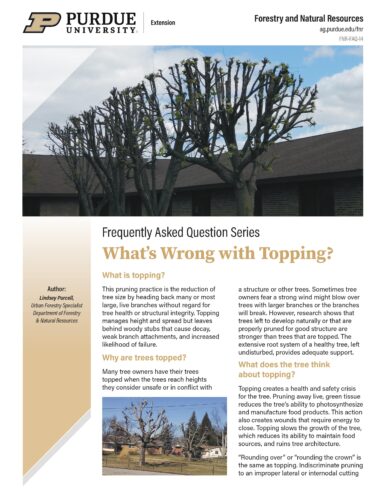 As trees grow and reach heights which many consider to be unsafe, tree owners would often top their trees by reducing the tree size. This is by heading back most of the large, live branches from the tree. However, topping trees proves to be more damaging than beneficial.
As trees grow and reach heights which many consider to be unsafe, tree owners would often top their trees by reducing the tree size. This is by heading back most of the large, live branches from the tree. However, topping trees proves to be more damaging than beneficial.
Topping trees can cause decay, weak branch attachments, and an increased likelihood of failure. If we do not top our trees and leave them to develop naturally, the structural strength of the trees is stronger than those that are not topped. The extensive root system, when left undisturbed, provides adequate support for the trees.
This publication titled What’s Wrong with Topping goes in-depth on the implications of topping and provides better alternatives to topping.
To view other urban forestry publications and video resources, check out Purdue Extension’s The Education Store website.
Resources:
Planting Your Tree Part 1: Choosing Your Tree, Purdue Extension YouTube Channel
Tree Planting Part 2: Planting a Tree, Purdue Extension YouTube Channel
Tree Selection for the “Un-natural” Environment, The Education Store, Purdue Extension resource center
Tree Installation: Process and Practices, The Education Store
Tree Pruning Essentials, The Education Store
Tree Pruning Essentials Video, Purdue Extension YouTube Channel
Lindsey Purcell, Urban Forestry Specialist
Purdue Department of Forestry and Natural Resources
Spring is here! It is the time of year for some of us to be planting new trees. In this Ask an Expert session, we welcome Lindsey Purcell, urban forestry specialist, as he teaches us how to plant and properly care for our trees. He goes over the tree selection process, including which invasive species trees we should avoid, and how to continue to take care of our trees once planted.
If you have any questions regarding wildlife, trees, forest management, wood products, natural resource planning, or other natural resource topics, feel free to contact us by using our Ask an Expert web page.
Resources:
Planting Your Tree Part 1: Choosing Your Tree, Purdue Extension YouTube Channel
Tree Planting Part 2: Planting a Tree, Purdue Extension – Forestry and Natural Resources YouTube Channel
Indiana Invasive Plant List, Indiana Invasive Species Council, Purdue Entomology
Alternatives to Burning Bush for Fall Color, Purdue Landscape Report
Invasive Plant Species: Callery Pear, The Education Store, Purdue Extension
Equipment Damage to Trees, Purdue FNR Extension
Landscape Report Shares Importance of Soil Testing, Purdue FNR Extension
Lindsey Purcell, Urban Forestry Specialist
Purdue Department of Forestry and Natural Resources
Question: Can I plant grass over soil where a newly removed stump was ground out?
Answer: We generally don’t want to plant new trees or turf immediately over the top of existing stumps in landscapes. The reasoning is a bit complicated but somewhat simple. The stump 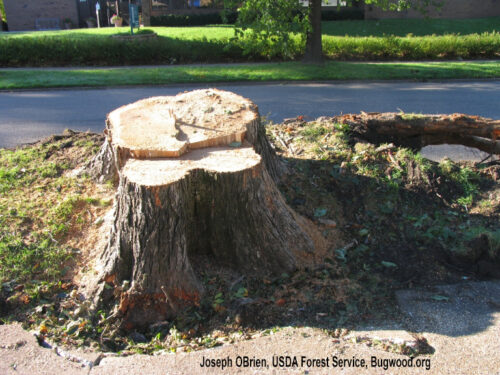 location will have limited soil and rooting depth for nutrient uptake and structural stability due to its remaining below ground mass.
location will have limited soil and rooting depth for nutrient uptake and structural stability due to its remaining below ground mass.
The woody debris material created from stump grinding has a high carbon to nitrogen (C:N) ratio. This reduces nitrogen availability for the new tree or grass. Also, there will be significant settling of the ground below the stump as it decays and loses its structural fiber. The soil should be added to replace the below ground roots and stump. It can take several years to fully decompose the stump unless it was ground very deeply or removed with an excavation machine.
The recommendations are adding soil to the stump area, and a little additional soil mounded to compensate for some decay. Plant the grass, preferably sod, however, seed can work, to adequately cover the newly exposed area. Be sure to add slow-release turf fertilizer to compensate for the high C:N ratio that will be robbing nutrition from the newly installed turf. Maintain adequate moisture and look for signs of yellowing, indicating low nitrogen levels.
Also, sprouts may be generated due to the roots acting as energy storage for the tree. Simply treat them with typical lawn herbicide as needed at the label recommended rates.
Resources:
Fundamentals of Turfgrass Management, The Education Store, Purdue Extension Resource Center
Taking Care of Your Yard: Homeowner’s Essential Guide to Lawns, Trees, Shrubs, and Garden Flowers, The Education Store, Purdue Extension Resource Center
Homeowner Conservation Practices to Protect Water Quality, Purdue Rainscaping, Purdue Extension Resource Center
Planting Your Tree Part 1: Choosing Your Tree, Purdue Extension YouTube Channel
Purdue Landscape Report
Lindsey Purcell, Chapter Executive Director
Indiana Arborist Association
Curious about the upcoming cicada emergence? What is different about this species than the ones you see every summer? What effect can they have on wildlife or on your trees and shrubs? Find out from Purdue Extension wildlife specialist Jarred Brooke, forester Lenny Farlee and Purdue Entomology’s Elizabeth Barnes. Don’t miss the question and answer time with our experts discussing “all things cicadas”.
If you have any questions regarding wildlife, trees, forest management, wood products, natural resource planning or other natural resource topics, feel free to contact us by using our Ask an Expert web page.
Resources:
Billions of Cicadas Are Coming This Spring; What Does That Mean for Wildlife?, Got Nature? Blog, Purdue Extension-Forestry and Natural Resources (FNR)
17-year Cicadas Are Coming: Are You Ready?, Purdue Landscape Report
17 Ways to Make the Most of the 17-year Cicada Emergence, Purdue College of Agriculture
Periodical Cicada in Indiana, The Education Store, Purdue Extension resource center
Cicada Killers, The Education Store
Purdue Cicada Tracker, Purdue Extension-Master Gardener Program
Dr. Elizabeth Barnes, Exotic Forest Pest Educator
Purdue Department of Entomology
Lenny Farlee, Sustaining Hardwood Extension Specialist
Purdue Forestry and Natural Resources
Jarred Brooke, Wildlife Extension Specialist
Purdue Forestry and Natural Resources
Most of us have probably heard or seen a lot about pollinators in the media recently. The reason why is that pollinators are really, really important. We simply can’t live without them. Researchers estimate that one out of every three bites of food we eat is made possible by pollinators. More than 100 food crops in the U.S. depend on pollinators, including almost all fruit and grain crops.
There are many different types of pollinators including native bees, butterflies and moths, beetles, flies, wasps, and of course hummingbirds. But perhaps one of the more interesting pollinators is the Monarch. Millions of Monarchs congregate in a relative small area in Mexico each winter. In March they start their journey north which has occurred over several generations. Unfortunately, the number of Monarchs counted in overwintering colonies has declined over the past 25 years.
In response, many states including Indiana have developed a state Monarch Conservation Plan. With input from many stakeholders over several years, the Indiana Monarch Conservation Plan was released in December 2020. One goal of the plan was to create an online resource that would act as a clearinghouse for Indiana monarch and pollinator conservation data, research, best management practices (BMPs), and events. I invite you to visit the Indiana Monarch and Pollinator Conservation Hub at https://indianawildlife.org/monarchs/.
You might be asking yourself, ‘Why is a wildlife specialist writing about pollinators?’ It turns out that quality habitat for wildlife is often quality habitat for pollinators. The diversity of wildflowers and structure that native grasslands, trees and shrubs benefit them all. Trees such as eastern redbud and Ohio buckeye provide early nectar sources. Native grasslands that have a diverse mixture of wildflowers provide food, bare ground, and structure desirable for a wide variety of pollinators.
Resources
Protecting Pollinators: Why Should We Care About Pollinators?, The Education Store, Purdue Extension resource center
Ask The Expert: What’s Buzzing or Not Buzzing About Pollinators , Purdue Extension – Forestry & Natural Resources (FNR) YouTube Channel
Purdue Pollinator Protection publication series, Purdue Extension Entomology
Indiana Monarch & Pollinator Conservation Hub, Indiana Wildlife Federation
Monarch Watch, University of Kansas
100 Plants to Feed the Monarch/Other Resources Available, Xerxes Society for Invertebrate Conservation
Brian MacGowan, Wildlife Extension Specialist & Extension Coordinator
Purdue Department of Forestry and Natural Resources
Purdue Landscape Report: PART 1 – The Importance of “Physical” Soil Testing
In my 40 years of teaching and consulting, one of the biggest and most frustrating problems I continually encounter is when so called “landscape professionals” and homeowners continue to apply annual soil fertilizers, lime, and other soil amendments without ever conducting a professional soils test.
Before planting long-lived trees, shrubs, flowering perennials and lawns, it is absolutely essential to have your soil tested for its physical, chemical, and biological properties. To have a beautiful landscape, an awesome lawn, or a very productive vegetable garden, we need to do soil tests because the health and vigor of everything we grow is directly dependent on the soil we are growing our plant’s roots in.
As an analogy, when you go to a family doctor or physician, why will they usually require a professional blood test from you? They want to “show you the numbers” of your cholesterol, HDL, LDL, triglycerides, sodium, potassium, and a whole array of other very important blood tests. Again, if they prescribe you to take medications, but they are not helping and can actually hinder your health, lawsuits can definitely occur. I tell my students, before anything is applied on a client’s property, “show me the numbers”!
Although many intelligent homeowners and landscapers may have initially done a chemical soil test, many have never done a soil texture, soil compaction, and/or soil drainage test on their property or their clients. Why do we need to do these “physical” soil tests? Think about it. For root growth, its not just about nutrient deficiencies, toxicities, or soil acidity problems, its about life giving oxygen in the root zone. Without oxygen, the entire ecosystem below ground will suffer. This is why I recommend you to determine your soil texture, (sand, silt, and clay %’s). Professional soils labs can determine your soil’s texture and that is very important, not only for knowing how much and when to water, but to determine what kind of fertilizers will work best for your soil. Many sandy soils are nutrient deficient because they have little negatively charged organic matter or clay to hold onto the positively charged nutrient fertilizers (cations). Excess rain and watering will leach many of the quick-release fertilizers, especially nitrate and potassium out of the root zone. This is why I recommend slow-release fertilizers on most soils so your plant’s roots will have available nutrients for a much longer time.
Resources
Soil Sampling Guidelines, The Education Store, Purdue Extension resource center
Soil Testing for Lawns, The Education Store
Consumer Horticulture: Collecting Soil Samples for Testing, The Education Store
Certified Soil Testing Laboratories, Purdue Extension – Master Gardener Program
Example soil test form
Chris Carlson, Associate Professor
Kent State University Arboriculture & Urban Forestry
In this edition of ID That Tree, Purdue Extension forester Lenny Farlee introduces you to the white oak group. In addition to identifying four common varieties of white oak by their leaves and acorns, he also explains how to differentiate them from their cousins, the red oaks.
If you have any questions regarding trees, forests, wildlife, wood products or other natural resource topics, feel free to contact us by using our Ask an Expert web page.
Resources
White Oak, The Education Store, Purdue Extension – Forestry and Natural Resources
FNR Hardwood – White Oak, The Purdue Arboretum Explorer
White Oak, Native Trees of Indiana River Walk, Purdue – Fort Wayne
ID That Tree, Playlist, Purdue Extension – Forestry and Natural Resources Youtube Channel
A Woodland Management Moment, Playlist, Purdue Extension – Forestry and Natural Resources Youtube Channel
Investing in Indiana Woodlands, The Education Store
Tree Appraisal and the Value of Trees, The Education Store
Forest Improvement Handbook, The Education Store
Lenny Farlee, Sustaining Hardwood Extension Specialist
Purdue University Department of Forestry and Natural Resources
In this edition of ID That Tree, we introduce you to the cucumber magnolia. This native Indiana species is much like other members of the magnolia family, except it has green cucumber like fruit and a unique bark. Learn more from Purdue Extension forester Lenny Farlee.
If you have any questions regarding wildlife, trees, forest management, wood products, natural resource planning or other natural resource topics, feel free to contact us by using our Ask an Expert web page.
Resources
Indiana’s Native Magnolias, The Education Store, Purdue Extension resource center
Cucumber Magnolia, Native Trees of Indiana River Walk, Purdue Fort Wayne
Magnolia Acuminata, The Purdue Arboretum Explorer
ID That Tree, Purdue Extension – Forestry & Natural Resources Playlist
A Woodland Management Moment, Playlist
Investing in Indiana Woodlands, The Education Store, Purdue Extension resource center
Forest Improvement Handbook, The Education Store
Lenny Farlee, Sustaining Hardwood Extension Specialist
Purdue University Department of Forestry and Natural Resource
Recent Posts
- Ask An Expert: What’s Buzzing or Not Buzzing About Pollinators, Webinar
Posted: July 4, 2023 in Forestry, Gardening, How To, Plants, Wildlife - Magnificent Trees of Indiana Webinar
Posted: May 12, 2023 in Forestry, Forests and Street Trees, Gardening, Got Nature for Kids, Urban Forestry, Webinar, Woodlands - Be Tick Aware: Lyme Disease & Prevention Strategies Webinar
Posted: May 11, 2023 in Alert, Forestry, Forests and Street Trees, Gardening, How To, Urban Forestry, Webinar, Wildlife, Woodlands - Illinois Groundwork provides a rich supply of green infrastructure resources – IISG
Posted: in Gardening, Land Use, Plants, Wildlife - Pseudomonas syringae pv. syringae on lilac and other woody ornamentals – Landscape Report
Posted: May 3, 2023 in Forestry, Forests and Street Trees, Gardening, How To, Plants, Safety, Urban Forestry, Woodlands - Publication-Introduction to Rain Garden Design
Posted: April 24, 2023 in Forestry, Gardening, How To, Plants - Kara Salazar Promoted to Aid in Leading Community Development
Posted: March 27, 2023 in Aquaculture/Fish, Aquatic/Aquaculture Resources, Gardening, How To, Land Use, Natural Resource Planning - Warm, wet spring predicted for Indiana
Posted: March 17, 2023 in Drought, Forestry, Forests and Street Trees, Gardening, Plants, Urban Forestry, Woodlands - Purdue Rainscaping Education Program Introduces Two New Videos
Posted: February 7, 2023 in Gardening, How To, Natural Resource Planning - Question: What can I do to stop the voles from eating my seedling roots?
Posted: February 2, 2023 in Forestry, Forests and Street Trees, Gardening, How To, Wildlife
Archives
Categories
- Alert
- Aquaculture/Fish
- Aquatic/Aquaculture Resources
- Ask the Expert
- Christmas Trees
- Community Development
- Disease
- Drought
- Forestry
- Forests and Street Trees
- Gardening
- Got Nature for Kids
- Great Lakes
- How To
- Invasive Animal Species
- Invasive Insects
- Invasive Plant Species
- Land Use
- Natural Resource Planning
- Nature of Teaching
- Plants
- Podcasts
- Ponds
- Publication
- Safety
- Timber Marketing
- Uncategorized
- Urban Forestry
- Webinar
- Wildlife
- Wood Products/Manufacturing
- Woodland Management Moment
- Woodlands
